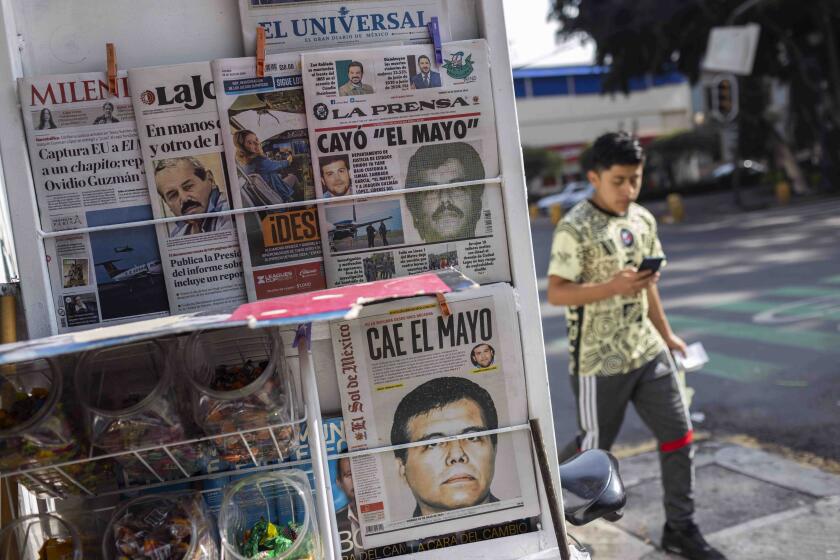Rising Rate of HIV Infection Renews Bathhouse Debate
Amid growing concerns about HIV infection among gay men, public health officials in Los Angeles County are once again facing the politically charged question of how to regulate gay bathhouses and sex clubs.
County health officials are considering tougher enforcement of existing laws that require bathhouse patrons to use condoms. They also are debating whether to impose the safe-sex rules on other types of gay sex clubs and require all to offer condoms, information on safe sex, and on-site testing for HIV and other sexually transmitted diseases. Facilities that don’t comply could be shut down.
The review was triggered by a recent Los Angeles County study that showed newly diagnosed HIV infections to be seven times higher among bathhouse patrons than among others who were tested for HIV. The Board of Supervisors ordered the health department to develop a proposal for updating the regulations by May 15.
The county’s epidemiologists have just begun to work out the details, but the process has already stirred up a debate that to some is reminiscent of one that raged during the early days of the AIDS crisis.
As in the early 1980s, public health officials and many AIDS activists worry that without intervention, the number of HIV cases will spiral out of control.
Now, as then, bathhouse owners and some gay rights activists argue that to close or restrict the bathhouses and sex clubs would infringe on the civil rights of patrons and business owners.
“When you start regulating whether or not people can have safe sex, maybe one day you’ll regulate whether people of the same sex can have sex with each other at all,” said lobbyist Steve Afriat, who was hired by several bathhouse owners to fight tougher regulation of the establishments.
“So there’s a resistance to having regulations on what the clubs can and cannot allow,” he said.
But those who favor more restrictions on bathhouses and sex clubs accuse the owners of trying to stir up old passions, at the expense of men who might become infected.
Twenty years ago, bathhouses were a flash point in the arguments over how to contain the emerging epidemic. In some cities men would line up around the block at the most popular spots for a night of typically unprotected, often anonymous sex in whirlpool baths, saunas and small private rooms.
To many in the gay community the baths were important symbols of their sexual liberation, but to epidemiologists the establishments were ground zero for the spread of HIV among gay men.
Those who advocated closing the bathhouses -- or even regulating them -- were booed or shouted down in public meetings. When San Francisco ordered its bathhouses closed in 1984, angry activists demonstrated at City Hall, and the city’s public health director received so many death threats that he wore a bulletproof vest for four months.
Now, with several national and local indicators showing that gay men are at increasing risk of HIV infection after years of declines, epidemiologists are again concerned about the role of bathhouses in the spread of infection.
Policy in Los Angeles
Unlike San Francisco, officials in Los Angeles County let its bathhouses stay open, passing instead an ordinance requiring owners to provide condoms and instruct patrons in safe-sex practices, as well as making the use of condoms mandatory during sexual activity.
A wholesale shutdown of the 11 gay bathhouses and sex clubs known to be operating in Los Angeles County is not likely, said Dr. Jonathan Fielding, the county’s director of public health, because research indicates that patrons will simply seek partners at other venues. Already, he said, the Internet seems poised to surpass bathhouses and sex clubs as a way to find partners or attend sex parties where multiple partners are available.
But the bathhouses and sex clubs do play an important role in transmission of the disease, and those in charge of safeguarding the public health need to confront that, Fielding said.
The best approach, he said, would be to draft new rules with the cooperation of the club owners. That way, there is a greater chance that educational messages about safe sex -- perhaps forgotten as a new generation has come of age since the epidemic began -- will get through to some of the men who are putting themselves at risk for HIV.
But once new regulations are in place, “I would not hesitate to close down a place that is recalcitrant,” Fielding said.
Among the few gay leaders actively calling for more regulation of the clubs is Michael Weinstein, president of the AIDS Healthcare Foundation and a frequent critic of county health policy.
“The debate always seems to counterpoise civil liberties to public health,” Weinstein said. “But if you are earning money in a commercial establishment from creating a sex environment, then you should be required to make that environment as safe as possible, or you shouldn’t be allowed to operate.”
The brewing dispute in Los Angeles is being carefully watched by the national Centers for Disease Control and Prevention, as well as public health directors in other cities and counties.
HIV infections are on the rise among gay men nationally, said Dr. Ronald O. Valdiserri, deputy director of the National Center for HIV, Sexually Transmitted Diseases and Tuberculosis Prevention for the CDC. At the same time, growing numbers of gay men appear to be engaging in unsafe sexual practices, Valdiserri said. The Los Angeles study, he said, supported anecdotal evidence from other surveys that showed that bathhouses and sex clubs continue to be key venues for high-risk behaviors.
“Across the United States, directors of sexually transmitted disease programs are very concerned about the role of bathhouses,” Valdiserri said.
The Los Angeles County study, which was funded by the CDC, highlighted a number of disturbing trends, according to several public health officials.
The research, which was centered at two clubs in 2001 and 2002, showed new diagnoses of HIV infection in 11% of those who underwent testing at the clubs during that period.
By comparison, just 1.5% of HIV tests conducted within the general population were positive, according to Trista Bingham, the epidemiologist who conducted the county study.
Even among gay men, Bingham said, the numbers for bathhouse patrons were high: Of gay men in Los Angeles County who have undergone HIV testing, 5.5% tested positive.
The same study showed that 71% of customers came specifically to have anonymous sex. More than a third said they engaged in higher risk behaviors in the clubs than in other locations, 16% said they engaged in group sex and 10% said they engaged in anal sex without using a condom.
About 36% of respondents reported using drugs before going to the clubs, which health officials say encourages unsafe behavior. Among the most widely used drugs, experts say, are methamphetamine combined with Viagra. The combination loosens inhibitions and allows patrons to have sex repeatedly with different partners.
“This is a major, moral issue of life and death,” said Supervisor Zev Yaroslavsky, who sponsored the motion directing the health department to develop better ways to regulate the clubs. “And shame on us if our discomfort in talking about this results in people dying.”
The issue of regulating or closing gay bathhouses and sex clubs has long been viewed as politically risky in Los Angeles, because public health officials -- and their elected bosses -- worry that such moves would infringe on the civil rights of gays and alienate voters.
The county already has the power to shut down some bathhouses that allow patrons to engage in unprotected sex. The existing ordinance, passed 16 years ago at the height of the AIDS crisis, also requires health inspectors to examine the venues quarterly.
But John Schunhoff, chief of operations for the Los Angeles County Office of Public Health Programs and Services, said that the law is vague, and that a subsequent court settlement that lays out specific protocols for the clubs only applies to two of the facilities currently in operation.
Inspections Difficult
Moreover, he said, inspecting the facilities has proved fruitless: As soon as word goes out among the patrons and staff that the health department has arrived, inappropriate activity ceases.
As a result of the limitations in the existing law, and the difficulty conducting inspections, the department has not moved to shut down a bathhouse in more than a decade, Schunhoff said.
In their meeting with bathhouse and club owners, health department officials plan to discuss changing the law to include all gay sexual encounter venues, whether or not they offer baths, and a requirement that all clubs offer free HIV testing on the premises. Also under consideration is a requirement for all of the clubs to obtain licenses from the health department. These licenses would probably require the facilities to enforce safe-sex rules or risk being closed.
It is not clear how the county would enforce the new regulations. Schunhoff and Fielding said they are not inclined to send undercover inspectors to the clubs, partly because of the expense and also because in any case it would be difficult to prove that patrons are engaging in unsafe practices.
Some bathhouse operators say the county should emphasize voluntary efforts to inform patrons of the dangers of HIV infection and ways to prevent it.
“You don’t get HIV from going to the baths,” said Scott Campbell, who manages two gay bathhouses and a sex club. “You get HIV from having unprotected sex.”
Campbell said his facilities already offer HIV testing four days per week, and require patrons to use condoms. He said he would not fight an ordinance that codified the prevention efforts that his clubs were already engaged in voluntarily.
And so an old dilemma has come back.
“It’s deja vu all over again,” said Dr. Mervyn Silverman, the former San Francisco public health chief who braved a political storm to close that city’s bathhouses in 1984. “To me it seems like it should not even be an issue today.”
More to Read
Sign up for Essential California
The most important California stories and recommendations in your inbox every morning.
You may occasionally receive promotional content from the Los Angeles Times.










